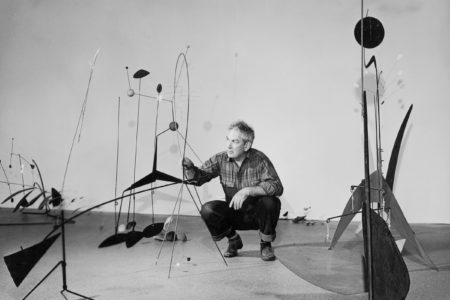Alexander Calder: Sculpture and Constructions
Produced by the Museum of Modern Art, New York. 16mm, color, sound (English); 10 min. Written and narrated by Agnes Rindge Claflin; cinematography by Herbert Matter; filmed and recorded by Hartley Productions.
Work in Progress
16mm, color reversal film original, silent; 14:40 min. Cinematography by Giulio Gianini. Unedited footage of first performance of Work in Progress (Teatro dell’Opera, 1967–68)....
27 April–9 May 1931
ChronologyCalder’s abstract work is presented for the first time in the exhibition “Alexandre Calder: Volumes–Vecteurs–Densités / Dessins–Portraits,” at Galerie Percier, Paris. Léger writes in the introduction to the catalogue:
Eric Satie illustrated byCALDER
Why not?
“It’s serious without seeming to be.”
Neoplastician from the start, he believed in the absolute of two colored rectangles. . . .
His need for fantasy broke the connection; he started to “play” with his materials: wood, plaster, iron, wire, especiallly iron wire. . . .a time both picturesque and spirited. . . .
. . . .A reaction; the wire stretches, becomes rigid, geometrical—pure plastic—it is the present era—an anti-Romantic impulse dominated by the problem of equilibrium.
Looking at these new works—transparent, objective, exact—I think of Satie, Mondrian, Marcel Duchamp, Brancusi, Arp—those unchallenged masters of unexpressed and silent beauty. Calder is of the same line.
He is 100% American.
Satie and Duchamp are 100% French.
And yet, we meet?
3–25 December 1940
Chronology“Calder Jewelry” is presented at Willard Gallery, New York. In her press release for the show, Willard writes, These works of art are savage and deliberate and self-confidently sophisticated . . . This is a master modern artist’s contribution to the history of fashion. For a world already in
chains it is superb stuff.
Spring 1969
ChronologyJaney Waney, commissioned by the N.K. Winston Corporation, is installed at the Smith Haven Mall in the Long Island village of Lake Grove. The force behind the site-specific project is the developer’s wife, Jane Holzer—or “Baby Jane,” a star of Andy Warhol’s films––for whom the sculpture was named.
1937–1945: Public Commissions and the War
Timeline
In 1937, Calder completed Devil Fish, his first stabile enlarged from a model. He received two important commissions: Mercury Fountain (1937) and Lobster Trap and Fish Tail (1939). His first retrospective was held in 1938 at the George Walter Vincent Smith Gallery in Springfield, Massachusetts, followed by another in 1943 at the Museum of Modern Art in New York.
